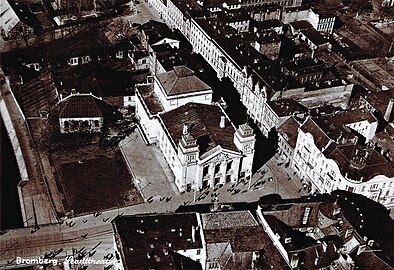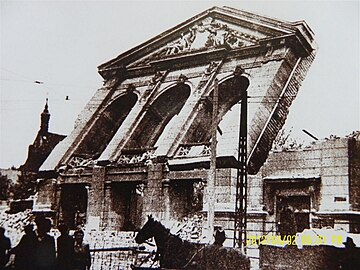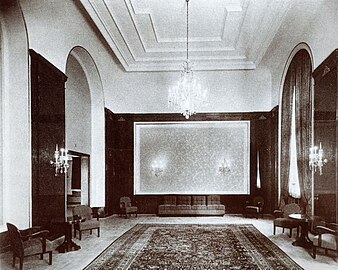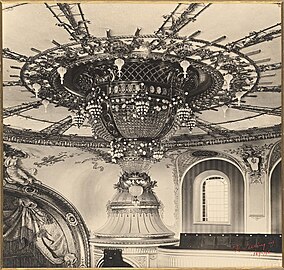Municipal Theatre, Bydgoszcz
| Former Municipal Theatre | |
|---|---|
Theatre square | |
| Town or city | Bromberg |
| Country | Poland |
| Coordinates | 53°7′30″N 17°59′13″E / 53.12500°N 17.98694°E |
| Construction started | 1895 |
| Completed | 1896 |
| Closed | 1945 |
| Technical details | |
| Floor count | 3 |
| Design and construction | |
| Architect(s) | Heinrich Seeling |
The Municipal Theatre of Bydgoszcz is a former theatre building which stood in Bydgoszcz, Poland from 1896 to 1946.
Location
The building was located downtown, on the
History
The history of the theater in Bydgoszcz dates back to the 17th century, when was built a special theatre hall in the city
The first performance occurred on October 3, 1896, honored by the presence of German Emperor
Prussian period (1895-1919)
At its beginnings, the theater staged off German art as one of the conditions for Prussian state financing the construction. The new theater building often attracted to Bromberg renowned European personnel. At the end of the 19th century, theater staff comprised 46 actors and 31 others (maintenance men, office managers, musicians). Famous playwrights were staged off: Goethe, Schiller, Shakespeare, Kleist, Calderon, Hauptmann, Ibsen, Victorien Sardou and others. Performances included tragedy, comedy, farce but also musical arts: opera (e.g. Richard Wagner), operetta, concerts by performers such as Richard Strauss (1899), Milan La Scala's orchestra (1899) or Eduard Strauss (1899, 1900).
Polish Period (1920-1939)

During the
- the actress Wanda Siemaszkowa,
- Józef Karbowski,
- Karol Benda,
- Władysław Stoma.
The latter led in 1937 the theatre to its most heyday, when most prominent Polish actors performed in Bydgoszcz. This year, the number of theatrical performances exceeded 350 performances and exposed not only dramatic arts, but also performances including operas, operettas and revues. At that time, the scene starred, among others, Ludwik Solski, Stefan Jaracz, Mieczysława Ćwiklińska, Kazimierz Junosza-Stępowski, Stanisława Wysocka and Hanka Ordonówna. The last Polish director was Alexander Rodziewicz.
The success of the theater led to new investments. In 1921, a refurbishment of the interior was realized, including a new Front curtain, and in 1937, the scene received a revolving stage and a parking lot was built near the front entrance. In 1936, the first broadcast studio of the "

Occupation period (1939-1945)
During World War II, new German actors arrived from Riga, relocated to Bydgoszcz, following the Molotov–Ribbentrop Pact. At that time performances were rather intimate, the 1943/44 season, staging puppets scene. After the proclamation of the total war, the theatre was closed for the 1944-1945 season.
Destruction of the building (1945-1946)
In 1945, during the fighting for the liberation of the city, the theatre building was hit by incendiary ammunitions, which set fire to the inside, where Soviet soldiers were billeted. The decision was then made to tear down the Municipal Theater, instead of restoring it.[4] Eventually, demolition happened in spring 1946, and lawn planted where the theatre stood.
The new theatre,
Architecture
Interiors of the Municipal Theatre consisted of two areas: one devoted to the
Distribution of seats of the auditorium were as follows:
- Ground floor - 333 places arranged as an amphitheater;
- Lower balcony - 163 seats;
- Back of the auditorium - 117 seats;
- Upper balcony - 116 seats;
- Balcony gallery - 70 seats.
German designer Ernst Westphal took part in the interior decoration, including the suspension of a huge crystal
The facades featured historicism and eclecticism styles, referring to modern neoclassicism. An innovative solution was to build two towers, flanking the entrance portal. Sculptures of Goethe and Schiller were placed in the recesses of the second storey of the facade. The elevation was crowned by a triangular pediment, with a Tympanum (architecture) which displayed a sculpture from Ernst Westphal: the Prussian eagle holding in its claws Bromberg coat of arms, surrounded by allegorical characters.
Along the
Gallery
-
Main facade, 1905
-
Bird eye view in the 1910s
-
Theatre demolition in 1946
-
Mock-up of the Theatre and its square
-
Interiors map
-
View of the auditorium, 1946
-
Foyer, 1946
-
Grand chandelier
See also
- Bydgoszcz
- Theatre square in Bydgoszcz
- Marshal Ferdinand Foch Street in Bydgoszcz
- Heinrich Seeling
- Gdańska Street, Bydgoszcz
- Grodzka Street in Bydgoszcz
- Mill Island in Bydgoszcz
References
- ISBN 97883-93447428.
- ^ Gill, Magdalena (22 October 2017). "Spacer śladami reportera papieża". tygodnikbydgoski.pl. Dom Wolnego Słowa. Retrieved 11 November 2022.
- ^ Krawczyk, Norbert (2004). Kulturalne radio PIK. Kalendarz Bydgoski. Bydgoszcz: Towarzystwo Miłośników Miasta Bydgoszczy. pp. 145–148.
- ^ Sucharska Anna, Bydgoski Teatr Miejski w latach międzywojennych, In. Kalendarz Bydgoski, 1983
External links
Bibliography
- (in Polish) Biskup, Marian (1991). Historia Bydgoszczy. Tom I do roku 1920. Warszawa-Poznań: Bydgoskie Towarzystwo Naukowe.
- (in Polish) Bręczewska-Kulesza, Daria (1999). Bydgoskie realizacje Heinricha Seelinga. Materiały do dziejów kultury i sztuki Bydgoszczy i regionu: zeszyt 4. Bydgoszcz: Pracownia dokumentacji i popularyzacji zabytków wojewódzkiego ośrodka kultury w Bydgoszczy.
- (in Polish) Derenda, Jerzy (2006). Piękna stara Bydgoszcz – tom I z serii Bydgoszcz miasto na Kujawach. Bydgoszcz: Towarzystwo Miłośników Miasta Bydgoszczy.
- (in Polish) Janiszewska-Mincer, Barbara (1986). Bydgoskie siedziby Melpomeny i Talii. Kalendarz Bydgoski. Bydgoszcz: Towarzystwo Miłośników Miasta Bydgoszczy. pp. 72–75.
- (in Polish) Janiszewska-Mincer, Barbara (1981). Wybitna aktorka i kłopoty z Teatrem Miejskim w Bydgoszczy. Kalendarz Bydgoski. Bydgoszcz: Towarzystwo Miłośników Miasta Bydgoszczy. pp. 109–112.
- (in Polish) Mrozek, Zdzisław (1993). Z tradycji teatralnych Bydgoszczy (do 1918 r.). Kalendarz Bydgoski. Bydgoszcz: Towarzystwo Miłosnikow Miasta Bydgoszczy. pp. 87–94.
- (in Polish) Oleradzka, Jadwiga (1991). Teatr Polski w Bydgoszczy 1920-1990. Kronika Bydgoska XI. Towarzystwo Miłosnikow Miasta Bydgoszczy - Bydgoskie Towarzystwo Naukowe. pp. 9–36.
- (in Polish) Sucharska, Anna (1983). Bydgoski Teatr Miejski w latach międzywojennych. Kalendarz Bydgoski. Bydgoszcz: Towarzystwo Miłosnikow Miasta Bydgoszczy. pp. 93–97.
- (in Polish) Umiński, Janusz (1996). Bydgoszcz. Przewodnik. Bydgoszcz: Regionalny Oddział PTTK "Szlak Brdy".









